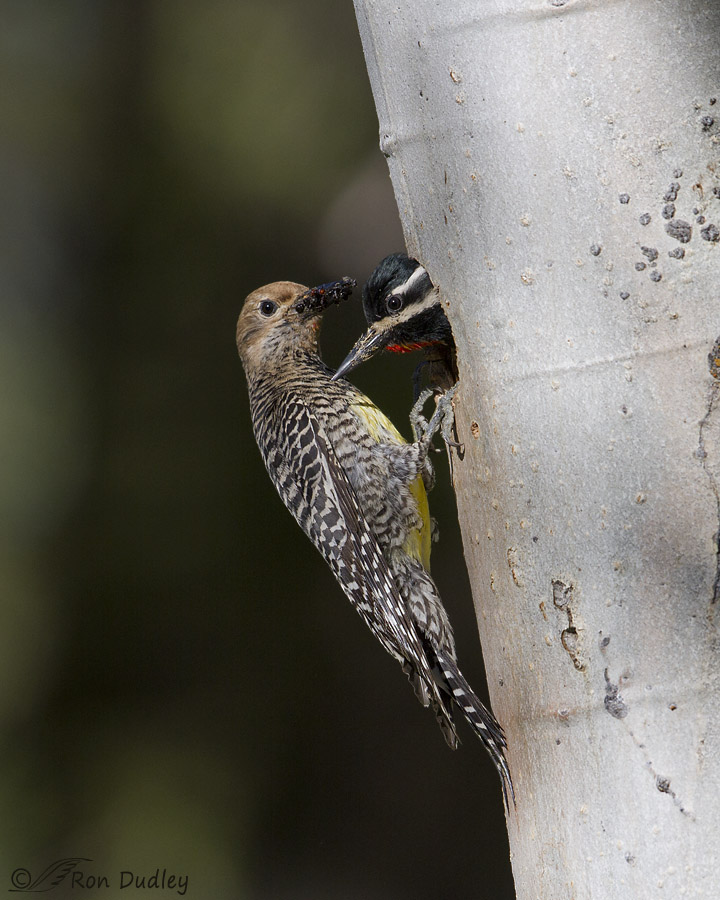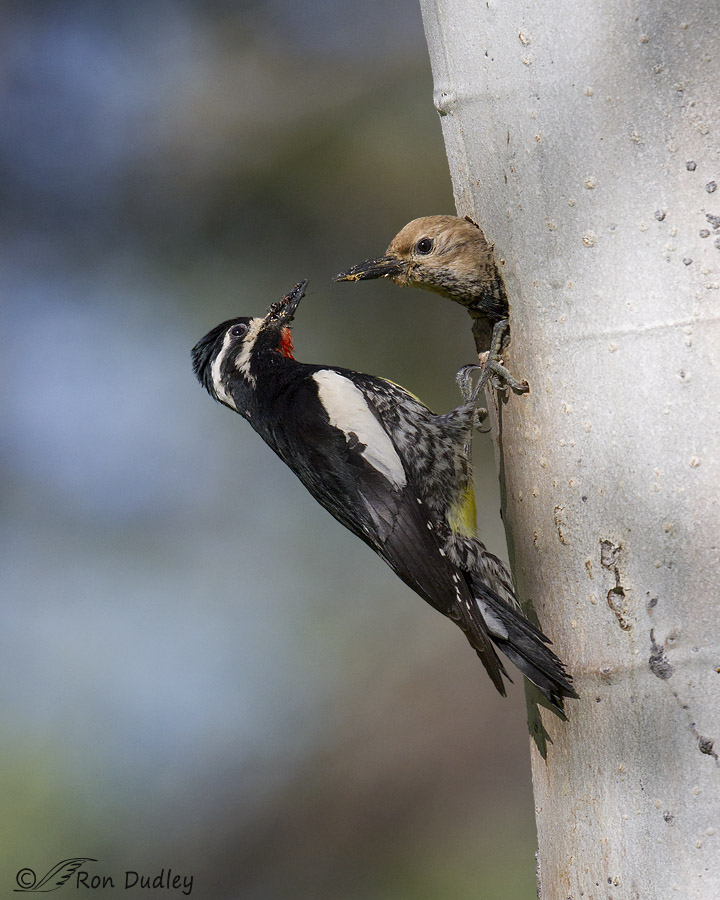I’ve seldom seen parental duties so enthusiastically and evenly shared as in this mated pair of Williamson’s Sapsuckers in Clark County, Idaho last July.

1/1600, f/6.3, ISO 500, Canon 7D, Canon EF500mm f/4L IS II USM, not baited, set up or called in
They had a brood of hungry youngsters in their nest cavity in an old, dead aspen who needed constant attention – meals delivered (mostly ants), excreta and wood chips removed from the cavity and guarding the nest hole from nosey avian neighbors who were attracted by all the commotion. In addition both parents had to keep themselves fed and groomed so the activity around the cavity was usually intense and almost constant.
Here the female on the left (this is the only woodpecker species to exhibit such spectacular sexual plumage differences – sexual dimorphism) is delivering a beak-full of ants to the chicks inside the nest but she must wait for the male to leave before she enters the cavity. He had arrived previously with his own load of ants.

1/2500, f/6.3, ISO 640, Canon 7D, Canon EF500mm f/4L IS II USM, not baited, set up or called in
Twenty three minutes later their roles are reversed as the male with ants waits for her to leave before entering the nest (his head is cocked to the side to avoid losing it during her explosive exit). While he was searching for food I could hear her pounding away inside as she further excavated the nest. She has excreta soaked wood chips in her bill that she will carry away when she leaves.
I’ve observed many nesting birds over the years but I don’t recall any whose nesting activities were more frenetic, time-consuming and energy intensive. It always made me wonder just how many hungry mouths were inside the nest waiting to be fed but of course I never did see the youngsters (average clutch size is 4-6 eggs) and could only guess.
Again I feel compelled to mention the potential risks to birds caused by photographing nesting activities. If birds feel threatened they may abandon the nest. This nest cavity was actually within an almost constantly used campsite so the birds were acclimated to human activity, my presence didn’t noticeably alter their behavior and my supertelephoto lens allowed me to photograph from a respectable distance.
We’re approaching the time of year when nesting birds are most vulnerable to human activities (including but certainly not restricted to nature photography) and I’m hoping to publish a post in the near future on that critical subject.
Please watch for it.
Ron


Very important message about intrusions on nesting activity, thank you. Great photos, love the activity and plumage.
Amazing shots and very interesting information Ron! Thanks so much for sharing!
Charlotte
Thanks, Charlotte.
Enjoyable as always.
Thank you, Arwen.
Parenting is never easy.
I loved seeing this busy pair again, and loved the reminder about not making their job harder.
No, it certainly isn’t, EC. It’s been a while since I raised a child but boy do I remember! I can’t imagine how challenging it is for most birds.
Fantastic series, Ron! I enjoyed last year’s photos of all the activity in and around that tree. During observation of nesting activities while gathering data for a breeding bird survey, I’m amazed how much energy is expended by many bird species. I think the woodpeckers are near the top of that activity list, as your notes seem to confirm.
Thanks for reminding us all to be responsible photographers, birders, observers.
Glad to see that you remember these birds from last year, Wally. I’ll sure never forget them. Thank you.
Hi Ron,
Thank you, as always. Last June, we here at the Klamath Bird Observatory held our first Mountain Bird Festival. The first if it’s kind, all outings practiced the concept of “Mindful Birding”, where the goal was to minimize disturbance to the birds (I wrote the guidelines). Some examples: visitors to a blind that overlooked a sensitive species’ nest were blindfolded to/from the location, no audio playbacks were allowed on any field trip, etc. Although some were concerned that our species totals would not be very high, the festival still recorded 173 species for two days of birding! And, our attendees applauded the concept! I am looking forward to your post, and I will spread the word.
Cheers from a member of the choir,
Dick
Loved the “Mindful Birding” concept, Dick. Personally, I’d like to see audio playbacks (electronic calls) completely lose favor in the birding community and eventually disappear from the scene altogether.
Great post, Ron!! We humans could learn something from the animal kingdom about good parenting! I also look forward to your post about proper behavior around nesting birds. Watching the Berry Eagle & the NE FL eagle nests you can see a big difference in tolerance of humans. The NE FL nest location is not shared by the Am. Eagle Found. that sponsors it & it’s in a secluded area. Yet the Berry Eagle nest is right by one of the Berry College’s busy parking lots with lots of activity. However, I’m very glad that there is still fencing & signs posted for the required distance to limit access. The cams have opened a wonderful view of so many wildlife creatures but if not educated we humans endanger the creatures we’ve come to love.
“if not educated we humans endanger the creatures we’ve come to love.”
Exactly, Jo Ann. I see significantly more human behaviors that harm birds out of ignorance than I do behaviors that are deliberate. In so many cases we’re “loving them to death”.
Great shots Ron, informative and interesting as usual. This pair of yours is certainly special!
However, I would put up the Eastern/Western Bluebird as equal to “frenetic, time-consuming and energy intensive” behavior. I photographed a pair of Eastern Bluebirds from July to August when the young fledged, and have never observed a species that was so intense on housekeeping and parenting as this pair of bluebirds.
Thanks for sharing!
You’re right about bluebirds, Dick. I’ve spent many hours watching Western Bluebirds at nesting. Push comes to shove, my money is still on the sapsuckers, though I’m sure it would be a photo-finish…
Wonderful image…love the comments….as always, humerous and informative. I look forward to a posting about nesting birds’ vulnerability to human interference, but fear you may be “preaching to the choir” and hope you can find a way to share this super important information with a wider audience….
Thanks, Patty. Sharing that message with a “wider audience” is already in the works, as you’ll see when (if…) I do the post. But preaching to the choir never hurts as choir members sometimes need reminding, as we all do.